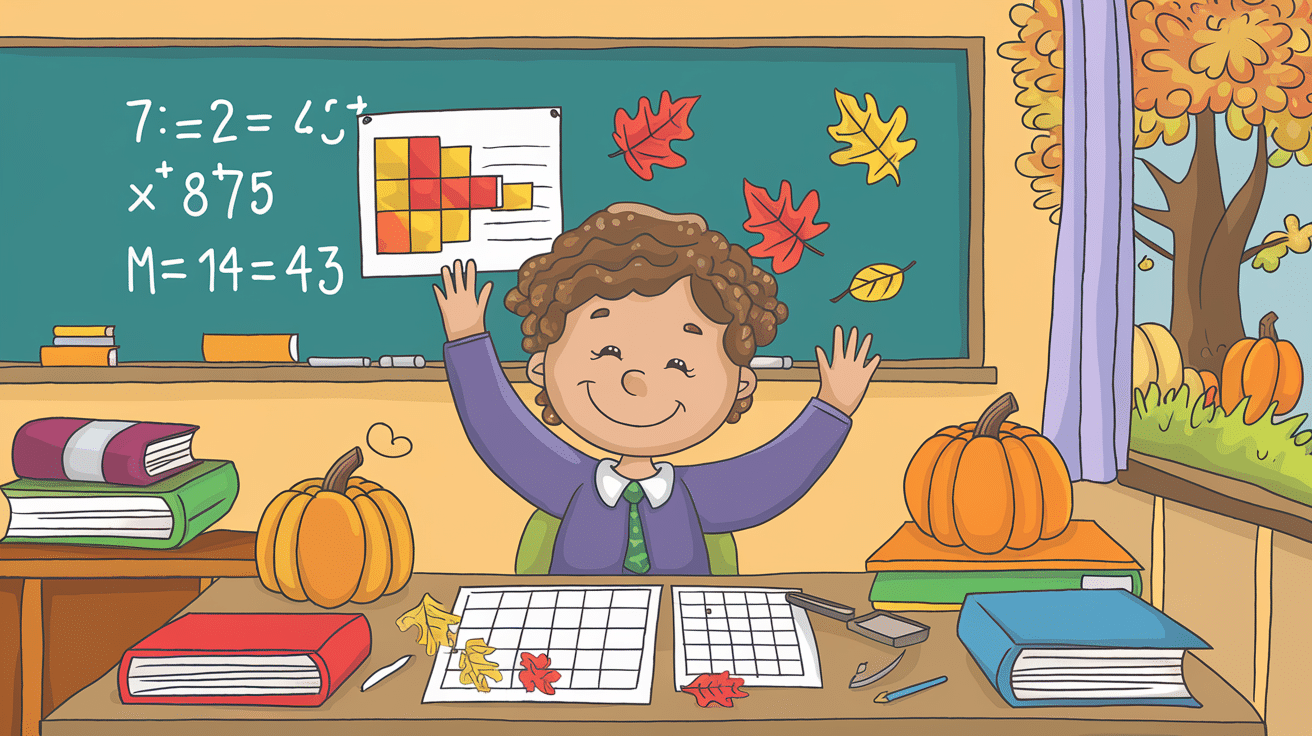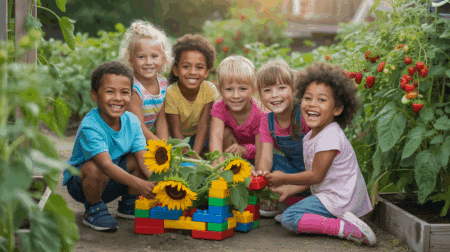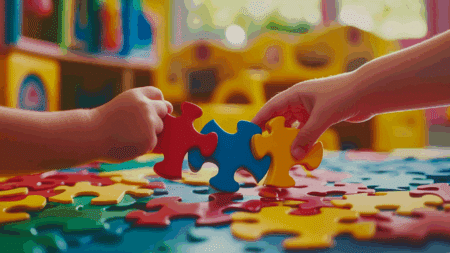Kids often groan when they hear the word “math.” But what if math lessons could be as fun as jumping in leaf piles? Fall offers countless ways to turn numbers into play.
The shift from summer to fall brings new chances to teach math concepts through seasonal items like apples, pumpkins, and colorful leaves. These items become perfect tools for counting, sorting, and pattern-making.
When children use real objects from nature to learn math, they see how numbers work in their daily lives. They start to connect classroom concepts with the world around them.
Ready to make math a highlight of your fall days? Try these simple activities that blend learning with the joys of the season.
Why Use Seasonal Themes in Math Activities?

Bringing seasonal themes into math teaching makes numbers come alive for students in ways textbooks simply cannot.
1. Makes learning feel fresh: When we connect math to the current season, students pay more attention. Fall items like acorns and leaves feel new and exciting compared to standard counters.
2. Creates real-world connections: Using fall objects helps children see how math exists all around them. Counting apples from a real orchard feels more meaningful than solving problems on paper.
3. Builds multiple skills: Seasonal math activities often combine skills. When sorting leaf colors, children practice both counting and grouping at the same time.
4. Appeals to different learners: Some kids learn best by touching and moving things. Fall-themed activities allow hands-on learning that works for all types of students.
5. Increases student joy: When math involves colorful leaves and pumpkins, children simply enjoy the learning process more. Happy students learn better and remember more.
These seasonal connections help math stick in young minds long after the fall leaves have fallen.
Easy Fall Math Activities for Preschoolers to Boost Learning

1. Pumpkin Counting
A simple counting activity using mini pumpkins, where children count and group them by size or color.
- Ideal Age: 3-5 years
- Materials Needed: Mini pumpkins, baskets
- How to Play: Have kids count pumpkins and sort them by color or size.
- Math Skill: Counting, sorting
2. Apple Shape Hunt
Search for apples in different shapes or cut out paper apples with different shapes.
- Ideal Age: 3-5 years
- Materials Needed: Paper apples, markers
- How to Play: Ask kids to identify and group apples based on their shapes.
- Math Skill: Shape recognition, sorting
3. Leaf Measurement
Use fallen leaves to teach kids how to measure length using non-standard units like blocks.
- Ideal Age: 4-5 years
- Materials Needed: Fallen leaves, blocks or toy cars
- How to Play: Measure the leaves by lining them up with blocks or toys.
- Math Skill: Measurement, comparison
4. Counting Acorns
Count a set of acorns and compare the quantities with the children.
- Ideal Age: 3-5 years
- Materials Needed: Acorns, bowls
- How to Play: Have children count acorns into bowls and compare amounts.
- Math Skill: Counting, comparison
5. Fall Pattern Making
Create simple patterns using fall-themed objects like leaves and pumpkins.
- Ideal Age: 3-5 years
- Materials Needed: Leaves, pumpkins, sticks
- How to Play: Children create and continue simple patterns.
- Math Skill: Pattern recognition, sequencing
6. Apple Orchard Sorting
Sort apples by color, size, or type in a pretend apple orchard.
- Ideal Age: 3-5 years
- Materials Needed: Apples (real or toy), baskets
- How to Play: Sort apples into different baskets by color or size.
- Math Skill: Sorting, categorizing
7. Pumpkin Number Tracing
Trace pumpkin-shaped numbers to practice number writing and recognition.
- Ideal Age: 3-5 years
- Materials Needed: Paper, markers
- How to Play: Trace numbers inside pumpkin shapes and practice writing them.
- Math Skill: Number recognition, fine motor skills
8. Fall Shape Hunt
Look for different shapes in the fall environment, like round pumpkins or square crates.
- Ideal Age: 3-5 years
- Materials Needed: Fall objects (real or pictures)
- How to Play: Identify and collect objects of various shapes in a fall setting.
- Math Skill: Shape identification, observation
9. Leaf Counting and Sorting
Count and sort leaves by size, color, or type.
- Ideal Age: 3-5 years
- Materials Needed: Fallen leaves, containers
- How to Play: Sort leaves into groups based on color or size, then count them.
- Math Skill: Counting, sorting
10. Pumpkin Graphing
Create a graph to compare pumpkin sizes or colors.
- Ideal Age: 4-5 years
- Materials Needed: Paper, crayons, pumpkins
- How to Play: Graph pumpkins based on different attributes like size or color.
- Math Skill: Graphing, data collection
Engaging Fall Math Activities for Classroom: Elementary Edition

11. Fall Graphing Fun
Create bar graphs based on the number of different fall items like leaves, pumpkins, or apples.
- Ideal Age: 6-8 years
- Materials Needed: Paper, colored pencils, fall items
- How to Play: Collect data about the number of fall items and create bar graphs.
- Math Skill: Graphing, data interpretation
12. Pumpkin Estimation Jar
Fill a jar with mini pumpkins and have students estimate how many pumpkins are inside.
- Ideal Age: 6-8 years
- Materials Needed: Mini pumpkins, jar, paper
- How to Play: Students make guesses and then count to check their estimates.
- Math Skill: Estimation, counting
13. Leaf Fraction Fun
Use real or paper leaves to demonstrate basic fractions like halves and quarters.
- Ideal Age: 7-9 years
- Materials Needed: Leaves (real or paper), scissors
- How to Play: Cut leaves into halves or quarters to teach fraction concepts.
- Math Skill: Fractions, division
14. Autumn Multiplication War
A card game where students multiply the numbers on two autumn-themed cards to find the product.
- Ideal Age: 8-10 years
- Materials Needed: Autumn-themed cards with numbers
- How to Play: Players multiply numbers on the cards and keep the highest product.
- Math Skill: Multiplication, number recognition
15. Apple Tree Division
Use apple images or real apples to show division by sharing apples evenly among groups.
- Ideal Age: 6-8 years
- Materials Needed: Apples or apple pictures, paper
- How to Play: Divide apples into equal groups and learn division concepts.
- Math Skill: Division, sharing
16. Pumpkin Pattern Challenge
Students create repeating patterns using fall items like pumpkins, leaves, or acorns.
- Ideal Age: 6-8 years
- Materials Needed: Paper, markers, fall-themed objects
- How to Play: Create and extend patterns using various fall-themed objects.
- Math Skill: Pattern recognition, sequencing
17. Corn Kernel Counting and Sorting
Count and sort corn kernels by color, size, or shape to practice basic math skills.
- Ideal Age: 6-8 years
- Materials Needed: Corn kernels, bowls
- How to Play: Sort and count kernels based on different attributes.
- Math Skill: Counting, sorting, categorization
Fun Fall Math Activities for High Schoolers

18. Pumpkin Parabola
Use the shape of a pumpkin to learn the concept of parabolas and quadratic functions.
- Ideal Age: 14-16 years
- Materials Needed: Graph paper, ruler, pumpkin pictures
- How to Play: Draw parabolas that model the shape of a pumpkin and solve quadratic equations.
- Math Skill: Quadratic functions, graphing
19. Autumn Budgeting Project
Students create a budget for a fall festival, using percentages to allocate expenses.
- Ideal Age: 14-16 years
- Materials Needed: Paper, calculators, budget sheet
- How to Play: Allocate a set amount of money to different fall festival expenses, using percentages for each category.
- Math Skill: Percentages, budgeting
20. Leaf Geometry
Analyze the geometry of leaves, calculating areas, angles, and symmetry.
- Ideal Age: 14-16 years
- Materials Needed: Fallen leaves, ruler, protractor
- How to Play: Measure angles and calculate the area of various leaves, examining their symmetry.
- Math Skill: Geometry, area, symmetry
21. Corn Maze Probability
Use a corn maze to teach probability by calculating the likelihood of choosing different paths.
- Ideal Age: 14-16 years
- Materials Needed: Corn maze diagram, paper
- How to Play: Students calculate the probability of various routes in a corn maze.
- Math Skill: Probability, decision-making
Pro Tips for Designing Fall-Themed Math Activities

Creating effective fall math activities takes more than just adding leaves to worksheets; here are tips to make your seasonal math truly effective:
- Use what’s available: Look around your yard or local park for free math materials. Fallen leaves, acorns, and pinecones make perfect counting objects that cost nothing but time to collect.
- Match the skill level: Make sure your fall math tasks fit your child’s current abilities. Too hard, and they’ll give up; too easy, and they’ll get bored. Start simple and add steps as they grow.
- Keep it hands-on: Children learn math best when they can touch and move items. Let them sort real apples by size or create leaf patterns instead of just looking at pictures.
- Take it outside: The fall weather is perfect for outdoor learning. Plan math walks where kids can find shapes in nature or count types of trees on your block.
With these tips, your fall math activities will be both fun and truly helpful for building number skills.
Wrapping It Up
Math doesn’t need to feel like a chore when autumn leaves start to fall. Through these seasonal activities, we’ve seen how everyday fall objects modify into valuable learning tools.
By bringing pumpkins, apples, and colorful leaves into math lessons, you help children connect numbers with the real world. This connection matters because it shows kids why math skills are important beyond the classroom.
What’s your next step? Pick one activity from this guide and try it this weekend. Start with something simple like sorting leaves by shape or counting seeds in a pumpkin. Watch how your child responds to math when it comes with a side of fall fun.
Have you created your own fall math activities? Share your ideas in the comments below!




